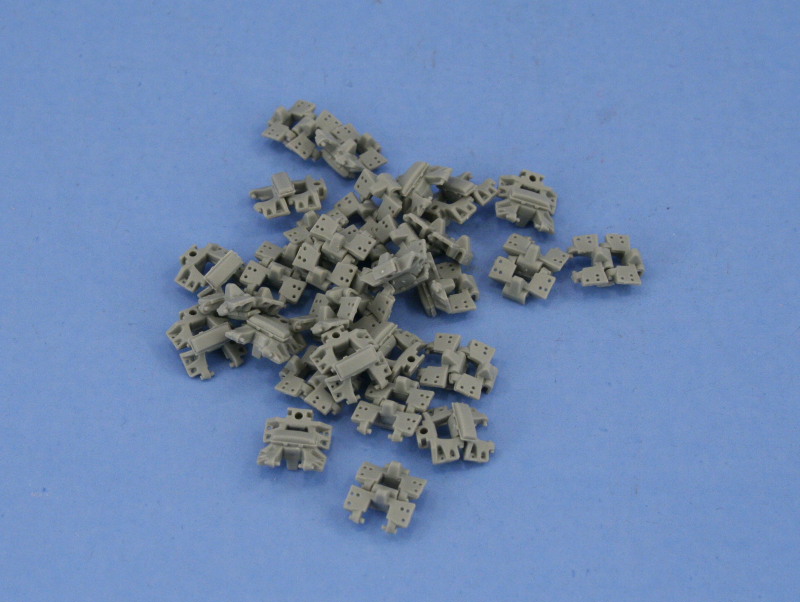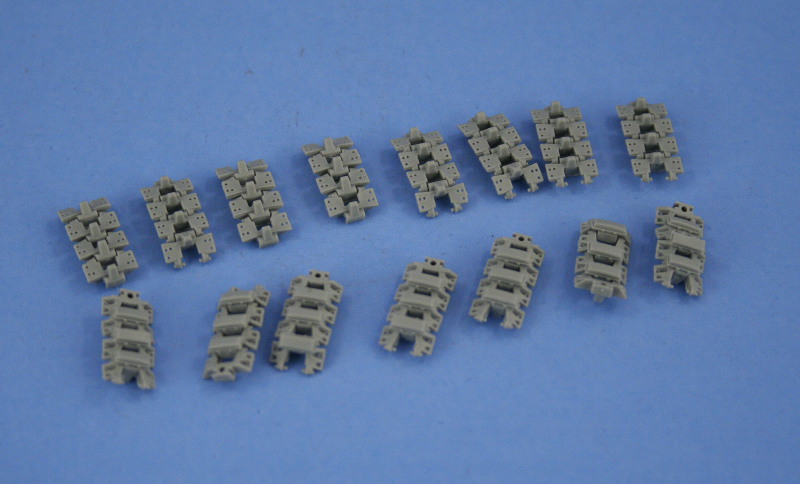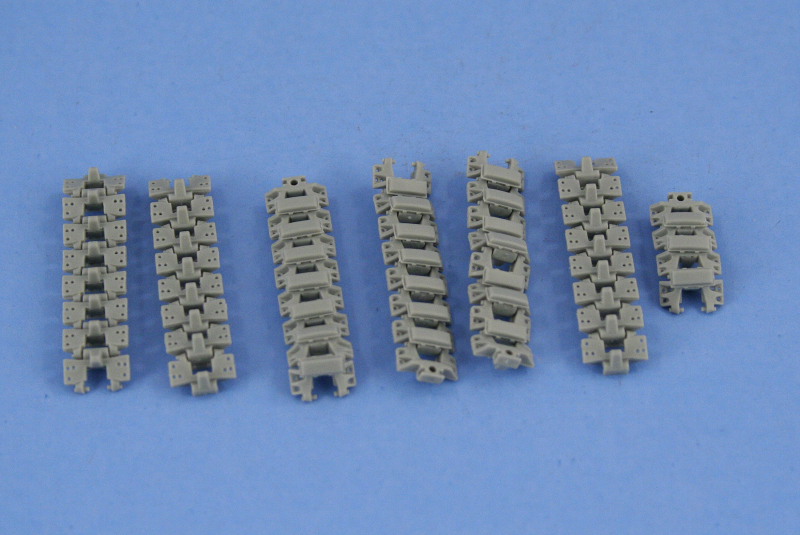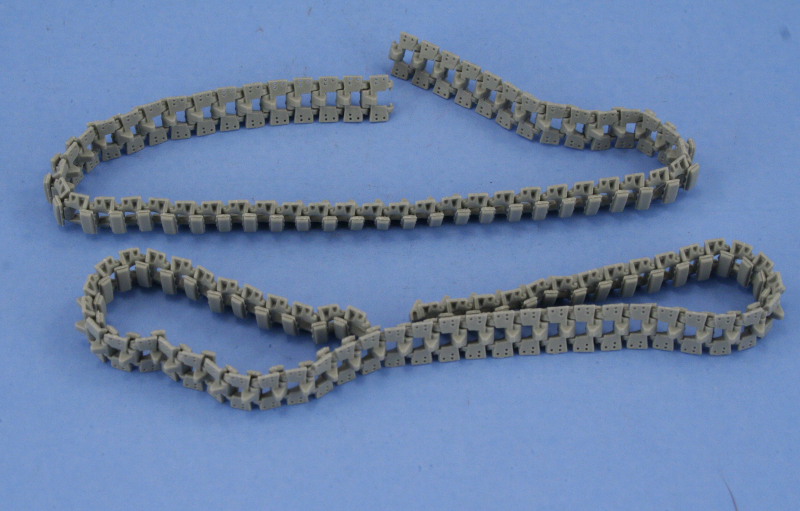Finishing off Step 10 from yesterday, I visited the rear hull and installed the jerry can racks after test fitting the cans to make sure I could slip them in later after hull painting is complete. The fit is tight, but not enough to make the legs pop off, so ought to be easy enough to accomplish. I also installed the tow hitch and reflector and noticed some small gaps that will need putty and sanding before painting but nothing serious.

Just as I was ready to move on from Step 10, I was checking some reference photos and realized that I made an error in the installation of the rifle racks...2 errors actually. The first was I installed the rack for the barrel ends upside down...and the second was I'd positioned them too far back...so both were removed, the glue marks sanded down, and then repositioned in the correct spot.

Step 11 deals with the installation of the fenders and their accompanying details and this step has several pitfalls in the instructions to watch out for. The first deals with the storage boxes. The instructions incorrectly pair up F3/F2 and F4/F5 for the boxes on the right and left sides respectively. If followed, this results in a mis-match between the tops and bottom of the storage boxes. The box pairs have one large and one small box and, after checking the references, the small box belongs at the front on both sides. Once I figured that out, it was easy to determine which tops belonged with which bottoms, but the issues didn't stop there. In order for these to install properly, there are some rivets on the fender that need to be removed, something that the instructions don't indicate as necessary. They also give the impression in the illustration that there are mount holes or pins that are used to secure the boxes in place, but there aren't any. Lastly, it's necessary for the boxes to overhang the fenders and sit flush against the hull, not on the surface of the fenders directly, so I held off installing them until after the fenders were mounted to insure a good fit and proper location. I also needed to adjust the right side front portion of the rifle racks to allow the turn indicator to fit properly and align correctly with the storage boxes. Finally, the boxes once installed had a small hollow spot for the smallest box at the front that needed some putty to fill so it wouldn't show as open to the outside but rather as a solid box. I noticed this only after installation and it would've been easier to fix with some sheet styrene vs. the putty prior to installation.
The next potential trouble spot in this step deals with the mud flaps. These are parts F24 and they have some very nice detail in the form of the reflectors that are molded in place...however the instructions show them only from the rear (no detail indications) and if you aren't aware of the proper alignment, it's possible to install them upside down. The reflector portion belongs on the bottom and the tops attach directly to the fenders with a small surface area so some good strong glue is needed to get them in place vs. liquid glue. Last but not least, each flap has a large sink hole visible on the inner surface that needs to be sanded down.
As if that weren't enough, there are also some glaring omissions in this step. Parts B10 and B11 are the front tow hooks and these, for some unknown reason, are marked as "not for use" yet they show up as magically installed in this step and are a necessary item for installation. Also marked as "not for use" are the rear brake light and convoy blackout light. These are parts B13 and B9 respectively and install on the right and left sides respectively yet strangely they not only never show as installed, the fender details of their mounts are also not depicted. Reference photos show that both should be present, so these were also installed. I checked the fit of part F8, a strange tool/crank of some type that I admit I've no idea what its function is, but mounts on the rear left fender and one of the bolt heads in this area also needed to be removed in order to accommodate it in the proper spot.
As a final send-off on this step, the blackout head lamp covers are shown installed with the slits straight up and down vs. horizontal...something that's not possible with they way the parts are designed, yet this arrangement continues on in the remainder of the instruction diagrams, so don't be lured into the desire to try to modify these...unless of course you want a truly unique look.



Moving out of the jungle of Step 11, I finished off the remaining tasks in Step 12 by installing the hull drop down sides in the closed position. This step directed the installation of the lower hinge points, parts F30, but I did that in Step 11 before fitting the fenders in order to have more room to work with them. I also installed, 3 per side, the PE foliage loops. These are very nicely done in PE but very, very small. Fortunately there are a couple extras provided on the fret, since the handles are also PE and have shallow connection points. I only needed one of the spares and will have to be very careful handling from here on out not to loose any others.

With that taken care of, I plunged onward to Step 13 which deals with the Flak gun. These steps are all the same from their stand-alone Flak 38 kit and were refreshing territory since I'd built one previously. This step provides the option of using PE for the gunner's sight shield, but since PE isn't provided for the main splinter shield, I stayed with the styrene one-piece. The right and left sides of the mount were constructed without any issues.

Step 14 deals with the Flak barrel construction and I replaced the styrene barrel with the Armorscale barrel. The installation is pretty straightforward, just a matter of cutting off the matching portion of the styrene barrel and then drilling a hole to take the mount pin on the aluminum portion. The gun mount and bearings were constructed along with the portion of the splinter shield that attaches to it and the barrel itself left loose to allow for painting and detailing separate from the mount.

Step 15 deals with the details of the base and joining the two halves of the mount together. The choice of 0 degrees, 20 degrees, 40 degrees, or 60 degrees elevation is presented with corresponding parts required and labeled on the following page under Step 17 to achieve the desired elevation. I went with 0 degrees and installed everything accordingly.


The only thing I didn't install is the gun sight, leaving this off so I can better paint and detail it separately. The direct fire gun sight had its eyepiece drilled out on both ends with a pin vise since it's molded solid.

All that's left to do with this one is construct the main splinter shields (these will be painted off the mount and installed later to allow access to all the nooks and crannies) and do the same for the spent shell casing basket. Construction should complete tomorrow and painting begin if the weather permits.



















































